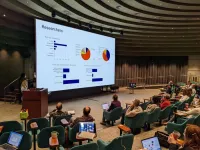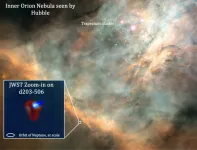(Press-News.org) EMBARGOED FOR RELEASE UNTIL 4 P.M. ET, THURSDAY, FEBRUARY 29, 2024
MINNEAPOLIS – Pedaling on a stationary bicycle built for two may improve the health and well-being for both people with Parkinson’s disease and their care partners, according to a small, preliminary study released today, February 29, 2024, that will be presented at the American Academy of Neurology’s 76th Annual Meeting taking place April 13–18, 2024, in person in Denver and online.
“Our study found that a unique cycling program that pairs people with Parkinson’s disease with their care partners can improve the physical, emotional and mental well-being of both cyclists to improve their quality of life,” said Jennifer Trilk, PhD, of the University of South Carolina School of Medicine in Greenville. “It is just as important that care partners also receive care, so that is why we included them as the cycling partner. The goal of our small study was to determine if tandem cycling was beneficial. The next step will be to confirm the results with subsequent studies that would include more participants.”
The study included 18 participants, nine with Parkinson’s disease and their corresponding nine care partners.
For the tandem cycling program, pairs of people with Parkinson’s disease and their care partners cycled on indoor, stationary tandem bicycles while using a virtual reality platform two times per week for eight weeks. During each session, all participants could visualize themselves cycling along real life, scenic outdoor routes by watching large television screens that were synced to the cycling intensity. The tandem cycling set-up also allowed the care partners to help adjust the cycling pace and facilitate a higher pedaling rate for greater health benefits.
Prior to starting the cycling program, all participants completed a series of tests. Participants repeated the same tests two days after the final cycling session eight weeks later.
For a test of resiliency, participants ranked a series of six statements regarding their perceived ability to bounce back or recover from stress. Statements were ranked on a scale of one to five, with higher numbers indicating stronger agreement. Statements included “I tend to bounce back quickly after hard times” and “I usually come through difficult times with little trouble.”
While people with Parkinson’s disease did not show improvements in resiliency, researchers found care partners demonstrated individual improvements in overall resiliency, which Trilk noted may help to decrease care partner burden. Care partners also demonstrated statistically significant improvements in depression scores after the cycling intervention.
Those with Parkinson’s disease completed additional disease-associated tests, including a questionnaire on how often they experience difficulties in daily living, including relationships, social situations and communication. They also completed physical tests, including a test used to gauge the severity and progression of their disease as well as a walking speed test.
People with Parkinson’s disease improved across their respective tests.
In the test measuring overall perception of difficulties in daily living, where higher scores indicate a lower quality of life, on a scale of zero to 100, participants decreased their total score by nearly five points, indicating improved overall quality of life. Participants with Parkinson’s disease also showed significant improvements in mobility on this test, in which they had a decrease of nearly 14 points, indicating improved overall physical function.
Researchers also found that participants with Parkinson’s disease had a decrease of eight points in the test gauging the overall motor severity and progression of their disease, where higher scores indicate greater disease burden. Overall scores range from zero to 132.
They also improved their walking speed, with an increase of 0.27 meters per second.
The study was supported by the Prisma Health-Upstate Office of Philanthropy and Partnership.
Learn more about Parkinson’s disease at BrainandLife.org, home of the American Academy of Neurology’s free patient and caregiver magazine focused on the intersection of neurologic disease and brain health. Follow Brain & Life® on Facebook, X and Instagram.
When posting to social media channels about this research, we encourage you to use the American Academy of Neurology’s Annual Meeting hashtag #AANAM.
The American Academy of Neurology is the world’s largest association of neurologists and neuroscience professionals, with over 40,000 members. The AAN is dedicated to promoting the highest quality patient-centered neurologic care. A neurologist is a doctor with specialized training in diagnosing, treating and managing disorders of the brain and nervous system such as Alzheimer’s disease, stroke, migraine, multiple sclerosis, concussion, Parkinson’s disease and epilepsy.
For more information about the American Academy of Neurology, visit AAN.com or find us on Facebook, X, Instagram, LinkedIn and YouTube.
END
Tandem cycling linked to improved health for those with Parkinson’s, care partners
2024-02-29
ELSE PRESS RELEASES FROM THIS DATE:
Preprints raise possibility of rethinking the peer-review process as they become more widely used and accepted
2024-02-29
Preprints raise possibility of rethinking the peer-review process as they become more widely used and accepted – new article encourages their growing momentum and provides recommendations to empower researchers to provide open and constructive peer review for preprints
#####
In your coverage, please use this URL to provide access to the freely available paper in PLOS Biology: http://journals.plos.org/plosbiology/article?id=10.1371/journal.pbio.3002502
Article Title: Recommendations for accelerating ...
A new channel for touch
2024-02-29
Every hug, every handshake, every dexterous act engages and requires touch perception. Therefore, it is essential to understand the molecular basis of touch. “Until now, we had known that the ion channel – Piezo2 – is required for touch perception, but it was clear that this protein alone cannot explain the entirety of touch sensation,” says Professor Gary Lewin, head of the Molecular Physiology of Somatic Sensation Lab at the Max Delbrück Center.
For over 20 years Lewin has been studying the molecular basis of the sensation ...
Scientists identify new ‘regulatory’ function of learning and memory gene common to all mammalian brain cells
2024-02-29
Johns Hopkins Medicine neuroscientists say they have found a new function for the SYNGAP1 gene, a DNA sequence that controls memory and learning in mammals, including mice and humans.
The finding, published March 1 in Science, may affect the development of therapies designed for children with SYNGAP1 mutations, who have a range of neurodevelopmental disorders marked by intellectual disability, autistic-like behaviors, and epilepsy.
In general, SYNGAP1, as well as other genes, control learning and memory by making proteins that regulate the strength of synapses — the connections between brain ...
Ultraviolet “winds” erode a young star’s protoplanetary disk in Orion Nebula
2024-02-29
Ultraviolet “winds” from nearby massive stars are stripping the gas from a young star’s protoplanetary disk, causing it to rapidly lose mass, according to a new study. It reports the first directly observed evidence of far-ultraviolet (FUV)-driven photoevaporation of a protoplanetary disk. The findings, which use observations from the James Web Space Telescope (JWST), provide new insights into the constraints of gas giant planet formation, including in our own Solar System. Young low-mass stars are often surrounded by relatively short-lived protoplanetary disks of dust and gas, which provide the raw materials from which planets ...
Pelagic fish more impacted by human pressures and protections than benthic species
2024-02-29
Pelagic fish – species that occupy the water column of the open ocean, neither near the bottom nor near the shore – are more impacted by both human pressure and protection than bottom-dwelling benthic species, researchers report. The findings highlight the need for increased marine protection in remote pelagic locations. Body size is a universal biological property that influences a range of ecological processes in marine ecosystems. Measuring body-size-structured variation can be a useful framework for understanding and predicting the impacts of overfishing or the success ...
Climate change is altering the seasonal pattern of river flow globally
2024-02-29
Climate change is altering the seasonality of river flow, particularly at high northern latitudes, according to a new study. Patterns in river flow vary with the seasons – a cycle that plays a critical role in floods and droughts, water security, and the health of biodiversity and ecosystems worldwide. Although recent studies have shown that climate change has already altered river flow seasonality (RFS), much of the evidence is limited to local regions or fails to consider the impact of climate change explicitly, independent of other human impacts to river flow. Consequently, the impact of climate warming on RFS isn’t ...
Conventional supply-side energy policies overlook benefits of demand-side policy approaches
2024-02-29
Energy security is a top priority across all levels of society because a host of global disruptions threaten energy systems and the critical functions they support. Most often, policymakers rely on policies and measurement indicators focused on energy supply to enhance energy security while ignoring demand-side possibilities. However, in a Policy Forum, Nuno Bento and colleagues argue that energy security is not solely security of supply; this limited focus fails to capture the full spectrum of vulnerability to energy crises. “Energy security is more than security ...
Radiation from massive stars shapes planetary systems
2024-02-29
How do planetary systems such as the Solar System form? To find out, CNRS scientists taking part in an international research team1 studied a stellar nursery, the Orion Nebula, using the James Webb Space Telescope2. By observing a protoplanetary disc named d203-506, they have discovered the key role played by massive stars in the formation of such nascent planetary systems3.
These stars, which are around 10 times more massive, and more importantly 100,000 times more luminous than the Sun, expose any planets forming in such systems nearby to very intense ultraviolet radiation. Depending on the mass of the star at the centre of the planetary system, this radiation can either help planets to ...
Climate change disrupts seasonal flow of rivers
2024-02-29
Climate change is disrupting the seasonal flow of rivers in the far northern latitudes of America, Russia and Europe and is posing a threat to water security and ecosystems, according to research published today.
A team of scientists led by the University of Leeds analysed historical data from river gauging stations across the globe and found that 21% of them showed significant alterations in the seasonal rise and fall in water levels.
The study used data-based reconstructions and state-of-the-art simulations to show that river flow is now far less likely to vary with the seasons in latitudes ...
Researchers reveal mechanism of how the brain forms a map of the environment
2024-02-29
When you walk into your kitchen in the morning, you easily orient yourself. To make coffee, you approach a specific location. Maybe you step into the pantry to grab a quick breakfast and then head to your car to drive to your workplace.
How these apparently simple tasks happen is of major interest to neuroscientists at Baylor College of Medicine, Stanford University and collaborating institutions. Their work, published in the journal Science, has significantly improved our understanding of how this occurs by revealing a mechanism at the brain cell level that mediates how an animal moves about in the environment.
“It’s been known that animals and people can find their ...



